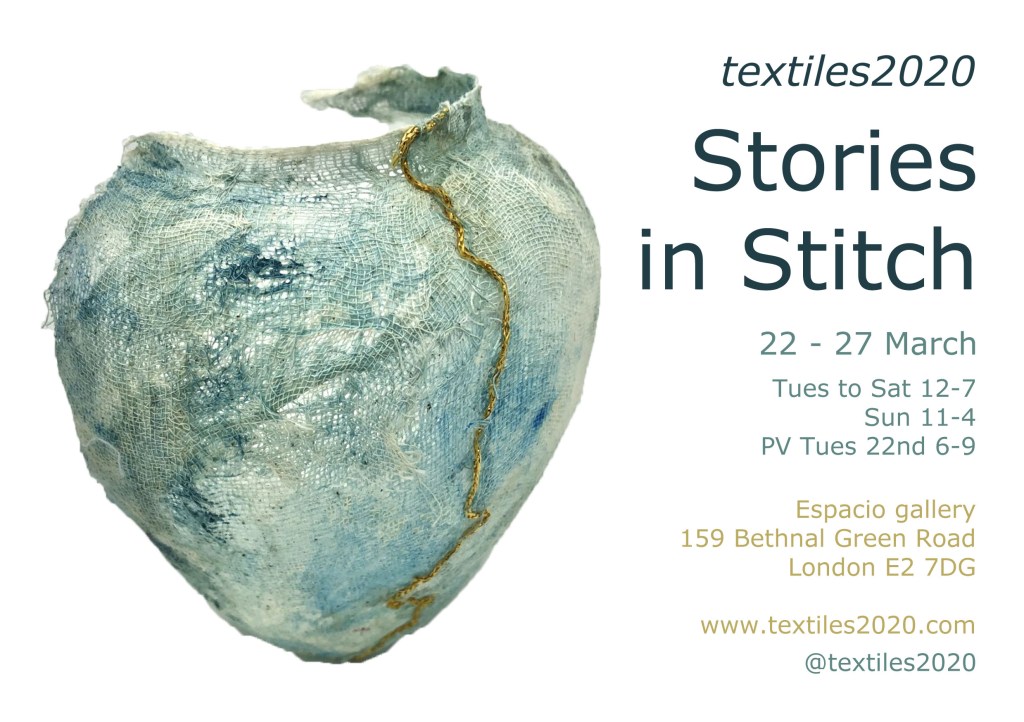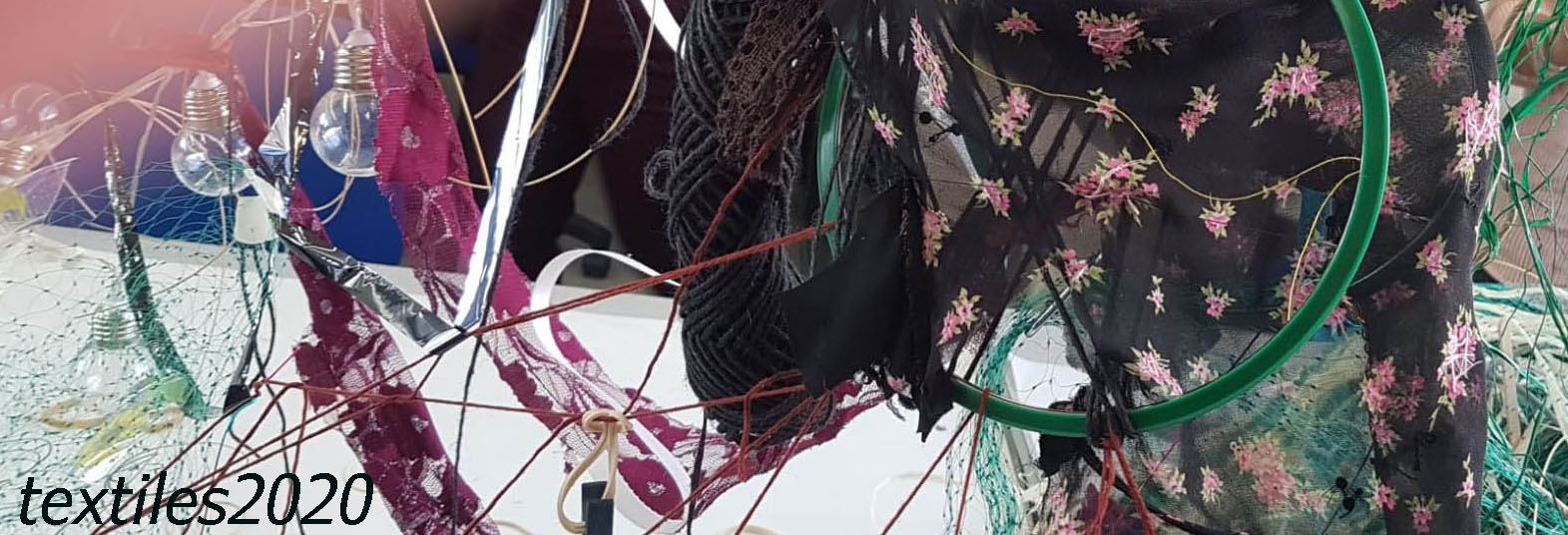at Espacio Gallery, London E2 7DG, from 22-27 March 2022

Clicking on the artist’s name will take you to their work: Kate Beale, Rachel Gillard Jones, Nina Gross, Karina Haake, Kathryn Hollingsworth, Ceridwen Sooke, Annika Strandberg, Gill Swanson, Patti Taylor, Veronica Thornton and Yvonne Watts.
Stories in Stitch is the theme for textiles2020 group show. Members illustrate events past and present, real or imagined using contemporary and traditional textiles techniques.
Gallery open daily from 12 –7, 11–4 on Sunday; private view Tuesday 6 to 9
We look forward to welcoming visitors to the exhibition, but if you can’t make it, all works will be displayed online once the show opens. Follow us on instagram @textiles2020
We would love to hear what you think – send your comments at the bottom of the page.
Kate Beale


In the absence of personal space that was family lockdown, meditation in art practice for Kate was a release, and a tool in preserving mental health. Kate’s practice adopts the simple repetitive process of the Japanese Itajime shibori technique of folding, clamping and dyeing silk fabric layer after layer, building subtle colours and pattern. It is slow and steady, and requires patience and focus, and is in itself a form of meditation.
Rachel Gillard-Jones







Rachel’s work brings to life some of the entries from a wartime diary of a young mum-to-be called Kathleen who lived in the industrial West Midlands in 1943. Commentary on global events intersperse with her often hilarious thoughts and opinions on daily life in wartime England. There are glimpses of “normal life” but reminders of hardship and the toll a lengthy war was taking on her, her friends and family.
All Rachel’s work is hand-stitched using repurposed, vintage or stash textiles and mixed threads.
Nina Gross
Nina works across multiple disciplines including animation, drawing, print and textiles. Materiality and time-intensive processes are integral to the work, balancing intuitive expression with focussed details. She uses poetry and prose to clarify thoughts and reflect on narrative. Shifting from literal starting points to broader, universal themes of time, memory and identity has allowed her work to obtain a fragile and ethereal presence that is introspective and reflective.


Comfort
Dolly struggles to sleep. Stop-frame animation exploring comfort and discomfort in their many forms.



Wanderings
Stop frame animation using experimental in and charcoal drawings to capture cycles of thought and rumination conjured whilst walking. Each frame appears by erasing the previous drawing. worn paper acts as a palimpsest leaving the photographic animation as the on record of the thought.
Hummings
Stop-frame animation using pencil and charcoal drawings. Thinking about time and belonging. Repetition, routine, journey and escape. Shifting preoccupation; unapologetically in your face, haunting sleep, flitting in the periphery, in our hands.
Karina Haake

Merino wool, sari silks
11 x 15cm
Framed: 25 x 25cm

Merino wool, sari silks
14 x 15cm
Framed: 25 x 25 cm

Merino wool, sari silks
11 x 15cm
Framed: 25 x 25cm

Merino wool, sari silks
11 x 15cm
Framed: 25 x25cm

Merino Wool, sari silks
11 x 15cm
Framed: 25 x 25cm









Approximate sizes: 8 x 4 x 3 cm
These tiny cases float weightlessly, frozen in time. Full of holes, they contain within them the memories and moments of their journeys: tickets, maps, letters, people half-remembered, places half-forgotten. Captured in time until they can venture out to journey again. The Traveller’s Case is inspired by travel and memory, which has always been a huge part of Karina’s life. Dedicated to her mother who taught her how to travel. Techniques include hand and machine embroidery, embellishing and felt. Silks, merino wool, paper.
Kathryn Hollingsworth














Scrim, muslin and gold thread
13 x 9 x 7 cm





Kathryn’s latest work is a personal story about loss which she explores with a series of empty and incomplete vessels. But there is a positive aspect – cups can be half full as well as half empty – so her process looks for harmony in what remains.
Kathryn’s work borrows from the ancient Japanese art of Kintsugi which celebrates mending the broken with beauty. She has created 3D vessels from fabric – mainly hand coloured scrim – and using the basket making technique looping.
Ceridwen Sooke







Ceridwen’s current work continues to be about colour, texture and form and references the many different organic shapes that are seen in the natural plant world.
Ceridwen is very interested in describing the forms in a linear way. She uses thread and stitch to create drawings in the air and creates small sculptural forms to enhance the work. Her work aims to be more about expressing the essence of what she is drawn to rather than to make a realistic interpretation of how things look.
Details from Living Wall, 130 x 180 cm paper string, embroidery threads, machine embroidery, embellished felt, fused plastic, silk fibres and forms.













Annika Strandberg



Annika said, “My second shock of 2020 was Menopause. I was seriously underinformed and some of the symptoms was unknown to me. Vertigo, sadness, frustration, anxiety, fatigue and lack of energy, feeling of invisibility, hearing problems, lack of motivation, and stranger dreams than normal. In this work I am trying to put symptoms and emotions on canvas and explore my feelings as I am getting to know the new self.”


Gill Swanson












Inspired by nature in all its forms, Gill enjoys working in an intuitive way randomly putting pieces together then possibly layering them or cutting them up and switching the shapes and forms around. By combining vibrant colours and textures she seeks to create artwork that reflects the powerful colours of plants and flowers. The beauty of autumn leaves has recently led Gill to experiment with different and unusual ways of introducing fallen leaves into her work.
Patti Taylor

Handstitched on 19th century hemp. Shows the most dangerous area for shipping off the south point of Spurn Head.
73 x 53 cm, framed

A long stitched, painted and printed scroll depicting the landscape of Spurn Point and the people who once lived there.
Canvas and other fabrics, threads, dyed scraps; specially made spindles and base.
50 x 25 x 10 cm

Double-sided images on organza tell the story of Robert Cross, one of the most highly decorated lifeboatmen in the country. Coxswain of the Humber Lifeboat from 1912 to 1944.
27 x 20 x 13 cm (opened)



Spurn notebook. A small notebook with workings out and experiments. 14 x 12 cm, approx











Patti’s current work is based on the changing landscape of Spurn Point. She tells the stories of its people, showing children at school and on the beach, the fishermen, the sloops off the spit and, poignantly, volunteer lifeboatmen in flimsy cork lifejackets. Researching their lives, she reveals the hidden courage, motivations and emotions which lie behind reported events. Techniques include hand and machine embroidery, print- and book-making, with recent success at the Royal Academy Summer Exhibition.

Veronica Thornton













Veronica’s latest work is inspired by a storm which swept down the east coast of Britain in Jan/Feb 1953 and caused much flooding and damage. The coastal communities were not warned of its coming and many were drowned as they slept. Low lying areas such as Jaywick and Canvey Island, housed in prefabs after the war, were particularly badly hit.
Veronica uses fragments of clothes, materials from the post war era, and details of maps which are embellished together to suggest a particular time and place.
Yvonne Watts





Yvonne’s work is inspired by her visits to a range of botanical spaces. She has made a series of silk prints using Polychromatic dye. She likes to focus on snatches of foliage to explore different compositions.
She creates mood by carefully mixing her own distinct colours from Proceon dyes.
Yvonne has also made a collection of vessels by combining paper mache with fabric and stitch. The vessels contain small stems of foliage which connect with the silk compositions.
Please leave a comment












